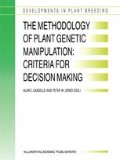Summary
A highly regenerable, isolated microspore system for barley, Hordeum vulgare L. cv. Igri, has been developed which is amenable to transformation studies using particle bombardment. The system allows DNA to be delivered to microspores at the single cell stage and both transient and stable transformation events have been demonstrated. The potential advantages of using isolated microspores as the target tissue in routine transformation systems are discussed.
Access this chapter
Tax calculation will be finalised at checkout
Purchases are for personal use only
Preview
Unable to display preview. Download preview PDF.
References
Becker, D., R. Brettschneider & H. Lorz, 1994. Fertile transgenic wheat from microprojectile bombardment of scutellar tissue. The Plant Journal 5: 299–307.
Bolik, M. & H.U. Koop, 1991. Identification of embryogenic microspores of barley (Hordeum vulgare L.) by individual selec-tion and culture and their potential for transformation by microin-jection. Protoplasma 162: 61–68.
Christou, P., T.L. Ford & M. Kofron, 1991. Production of transgenic rice (Oryza sativa L.) plants from agronomically important Indica and Japonica varieties via electric discharge particle acceleration of exogenous DNA into immature embryos. Biotechnology 9: 957–962.
Creissen, G., C. Smith, R. Francis, H. Reynolds & P. Mullineaux, 1990.Agrobacterium-and microprojectile-mediated viral DNA delivery into barley microspore-derived cultures. Plant Cell Rep. 8: 680–683.
Foroughi-Wehr, B., G. Mix, H. Gaul & H.M. Wilson, 1976. Plant production from cultured anthers of Hordeum vulgare L. Z. Pflanzenzüchtg. 77: 198–204.
Fromm, M.E., F. Morrish, C. Armstrong, R. Williams, J. Thomas & T.M. Klein, 1990. Inheritance and expression of chimeric genes in the progeny of transgenic maize plants. Biotechnology 8: 833– 839.
Gordon-Kamm, W.J., T.M. Spencer, M.L. Mangano, T.R. Adams, R.J. Daines, W.G. Start, J.V. O’Brian, S.A. Chambers, W.R. Adams, N.G. Willetts, T.B. Rice, C.J. Mackey, R.W. Krueger, A.P. Kausch & P.G. Lemaux, 1990. Transformation of maize cells and regeneration of fertile transgenic plants. The Plant Cell 2: 603–618.
Hoekstra, S., M.H. van Zijderveld, J.D. Louwerse, F. Heidekamp & F. van der Mark, 1992. Anther and microspore culture of Hordeum vulgare L. cv. Igri. Plant Sci. 86: 89–96.
Hoekstra, S., M.H. van Zijderveld, F. Heidekamp & F. van der Mark, 1993. Microspore culture of Hordeum vulgare L.: the influence of density and osmolality. Plant Cell Rep. 12: 661–665.
Hunter, C.P., 1987. European Patent Application No. 0 245 898 A2.
Kao, K.N., 1993. Viability, cell division and microcallus formation of barley microspores in culture. Plant Cell Rep. 12: 366–369.
Kikkert, J.R., 1993. The biolistic PDS-1000/He device. Plant Cell, Tissue and Organ Culture 33: 221–226.
Kohler, F. & G. Wenzel, 1985. Regeneration of isolated barley microspores in conditioned media and trials to characterize the responsible factor. J. Plant Physiol. 121: 181–191.
Kuhlmann, U., B. Foroughi-Wehr, A. Graner & G. Wenzel, 1991. Improved culture system for microspores of barley to become a target for DNA uptake. Plant Breeding 107: 165–168.
Last, D.I., R.I.S. Brettell, D.A. Chamberlain, A.M. Chaudhury, P.J. Larkin, E.L. Marsh, W.J. Peacock & E.S. Dennis, 1991. pEmu: an improved promoter for gene expression in cereal cells. Theor. Appl. Genet. 81: 581–588.
Li, L., R. Qu, A. de Kochko, C. Fauquet & R.N. Beachy, 1993. An improved rice transformation system using the biolistic method. Plant Cell Rep. 12: 250–255.
Nehra, N.S., R.N. Chibbar, N. Leung, K. Caswell, C. Mallard, L. Steinhauer, M. Baga & K.K. Kartha, 1994. Self-fertile transgenic wheat plants regenerated from scutellar tissues following micro-projectile bombardment with two distinct gene constructs. The Plant Journal 5: 285–297.
Olsen, F.L., 1991. Isolation and cultivation of embryogenic microspores from barley (Hordeum vulgare L.). Hereditas 115: 255–266.
Somers, D.A., H.W. Rines, W. Gu, H.F. Kaeppler & W.R. Bushneil, 1992. Fertile, transgenic oat plants. Biotechnology 10: 1589– 1594.
Vasil, V., A.M. Castillo, M.E. Fromm & I.K. Vasil, 1992. Herbicide resistant fertile transgenic wheat plants obtained by microprojec-tile bombardment of regenerable embryogenic callus. Biotech-nology 10: 667–674.
Wan, Y. & P.G. Lemaux, 1994. Generation of large numbers of independently transformed fertile barley plants. Plant Physiol. 104: 37–48.
Weeks, J.T., O.D. Anderson & A.E. Blechl, 1993. Rapid production of multiple independent lines of fertile transgenic wheat (Triticum aestivum). Plant Physiol. 102: 1077–1084.
Ziauddin, A., E. Simion & K.J. Kasha, 1990. Improved plant regen-eration from shed microspore culture in barley (Hordeum vulgare L.) cv. Igri. Plant Cell Rep. 9: 69–72.
Ziauddin, A., A. Marsolais, E. Simion & K.J. Kasha, 1992. Improved plant regeneration from wheat anther and barley microspore cul-ture using phenylacetic acid (PAA). Plant Cell Rep. 11: 489–498.
Author information
Authors and Affiliations
Editor information
Editors and Affiliations
Rights and permissions
Copyright information
© 1995 Springer Science+Business Media New York
About this chapter
Cite this chapter
Harwood, W.A., Bean, S.J., Chen, DF., Mullineaux, P.M., Snape, J.W. (1995). Transformation studies in Hordeum vulgare using a highly regenerable microspore system. In: Cassells, A.C., Jones, P.W. (eds) The Methodology of Plant Genetic Manipulation: Criteria for Decision Making. Developments in Plant Breeding, vol 3. Springer, Dordrecht. https://doi.org/10.1007/978-94-011-0357-2_14
Download citation
DOI: https://doi.org/10.1007/978-94-011-0357-2_14
Publisher Name: Springer, Dordrecht
Print ISBN: 978-94-010-4159-1
Online ISBN: 978-94-011-0357-2
eBook Packages: Springer Book Archive

